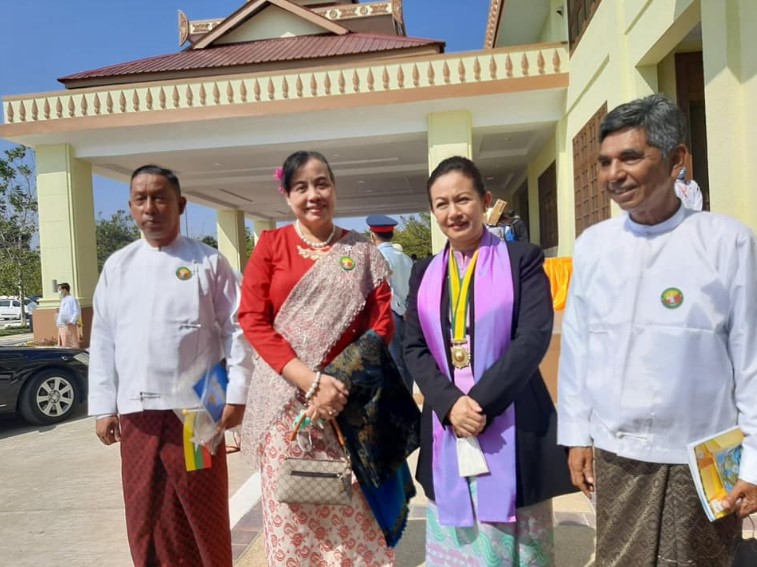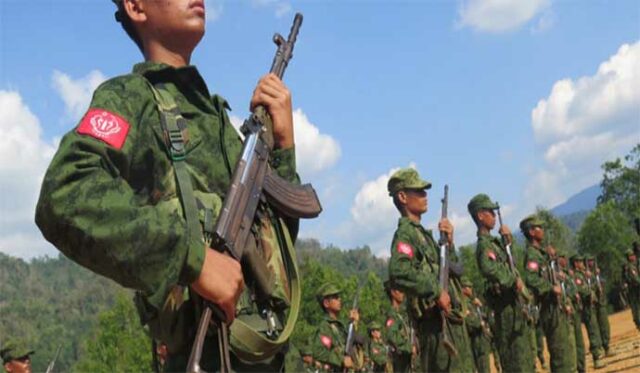The generals in Naypyitaw wanted ethnic armed organisations (EAOs) to attend the 75th anniversary of Union Day and they wished to demonstrate that they were ready to strike a deal with powerful enemies.
Seven of the 10 signatories to the Nationwide Ceasefire Agreement (NCA) and four non-signatories commemorated the 1947 signing of the Panglong Agreement between the pre-independence government and ethnic minorities.
At the weekend, only a few, smaller EAOs were represented by their leaders with most of the groups only sending relatively minor representatives.
NCA signatories the Restoration Council of Shan State and New Mon State Party were represented by central executive committee (CEC) members. The Arakan Liberation Party was represented by its vice-chairwoman Saw Mra Yazar Lin and Padoh Saw Shwe Maung, former Dupalaya district chairman Karen National Union, attended.
Representatives of the Lahu Democratic Union, the Democratic Karen Buddhist Army and the Karen National Union/Karen National Liberation Army – Peace Council also attended the event.
Among the non-signatories present were the United Wa State Army and the National Democratic Alliance Army, which sent liaison officers, the Shan State Progressive Party, which was represented by a CEC member and the Arakan Army (AA) was represented by Aung Mrat Kyaw, a brother of its chief Twan Mrat Naing, and veteran United League of Arakan (ULA) politician U Oo Hla Saw.
Observers said the regime was keen for the AA to send representatives and it made repeated approaches to the armed group and Rakhine politicians. In reply, AA leaders asked the regime to free its members who were detained in 2019 and 2020. The regime agreed as it appeared desperate to have the AA at the Union Day event. Until 2020, the regime called the AA “terrorists” and engaged in heavy fighting with the armed group in northern Rakhine.
Finally, a deal was reached. The AA agreed to send a representative to Naypyitaw with the regime insisting it was a senior member. The AA sent Aung Mrat Kyaw and U Oo Hla Saw, a former political prisoner and elected MP who became a political representative after last year’s coup.

The regime flew its guests to Naypyitaw from Rakhine State.
AA spokesman Khaing Thukha explained the reason the group attended. “We always attach great importance to the interests of our people. We, therefore, take a pragmatic approach to the needs of our people.”
On Union Day, junta chief Min Aung Hlaing pardoned 814 prisoners, a regular feature of major holidays, the regime’s media said. Unsurprisingly, 64 of the prisoners were AA members.
According to AA sources, several prominent leaders and military commanders remain in Myanmar’s prison. The AA also holds several prisoners of war in Rakhine State, including military officers and other ranks.
The AA poses a real threat to Myanmar’s military as the country has been in turmoil since last year’s coup, with mass protests and a subsequent military crackdown that has killed more than 1,500 civilians, according to the UN’s human rights office. The regime also confronts the new threat of people’s defense forces (PDFs) across the country.
Months before the coup, AA agreed an informal ceasefire with Myanmar’s military which largely seems to be holding despite several clashes.
Just days before the Union Day event, there were clashes and the junta suffered heavy casualties in Maungdaw Township.
The ULA is the political wing of the AA and has been building a separate administration in Rakhine State with a new judiciary, revenue department, public security offices and other governmental institutions. While the ceasefire holds, there is regular speculation about where fighting will break out next.
The AA began as a minor resistance group in 2009 but has grown to be one of Myanmar’s most powerful ethnic military forces.
After last year’s coup, Rakhine was largely spared the violence that sprung up everywhere else in Myanmar and the ULA’s parallel administration is now in de-facto control of the state, especially in the north.
The AA’s commander-in-chief, Gen. Tun Mrat Naing, has said in his speeches that he was working on a step-by-step approach to reclaim the lost sovereignty of the Rakhine people so they can restore their identity.
The regime is exhausted as it faces new armed insurrections and it cannot also fight the AA.
In the south of Rakhine State, the junta’s troops are still in control but the regime is losing control of the north.
Around 12,000 junta infantry troops are still in Rakhine State along with about 3,000 naval personnel and several thousand police and border guards.
It is clearly willing to meet AA demands and worries that the AA and some PDFs will unite to fight the junta.
The AA has already reportedly provided military training to PDFs in Rakhine. It appears to be playing a long game and is happy to attend the junta’s Union Day event for pragmatic reasons.
(By arrangement with ‘The Irrawaddy’)
















